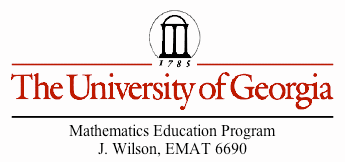
by: Doris Santarone
Lesson Plan: Geometric Transformations, Similar Triangles,
Right Triangle Trigonometry, and Trigonometric Functions
This lesson plan is intended to verticaly align some of the Geometry (and Algebra) concepts taught in Grades 6-12 and make connections amongst them. We will use technology to investigate four main topics.
Georgia Performance Standards:
M6G1. Students will further develop their understanding of plane figures.
a. Determine and use lines of symmetry.
b. Investigate rotational symmetry, including degree of rotation.
c. Use the concepts of ratio, proportion and scale factor to demonstrate the relationships between similar plane figures.
d. Interpret and sketch simple scale drawings.
e. Solve problems involving scale drawings.M7G2. Students will demonstrate understanding of transformations.
a. Demonstrate understanding of translations, dilations, rotations, reflections, andmrelate symmetry to appropriate transformations.
b. Given a figure in the coordinate plane, determine the coordinates resulting from a translation, dilation, rotation, or reflection.
Georgia Performance Standards:
M7G3. Students will use the properties of similarity and apply these concepts to geometric figures.
a. Understand the meaning of similarity, visually compare geometric figures for similarity, and describe similarities by listing corresponding parts.
b. Understand the relationships among scale factors, length ratios, and area ratiosbetween similar figures. Use scale factors, length ratios, and area ratios to determine side lengths and areas of similar geometric figures.
c. Understand congruence of geometric figures as a special case of similarity:The figures have the same size and shape.
3) Right Triangle Trigonometry
Georgia Performance Standards:
MM2G1. Students will identify and use special right triangles.
a. Determine the lengths of sides of 30°-60°-90° triangles.
b. Determine the lengths of sides of 45°-45°-90° triangles.
MM2G2. Students will define and apply sine, cosine, and tangent ratios to right triangles.
a. Discover the relationship of the trigonometric ratios for similar triangles.
b. Explain the relationship between the trigonometric ratios of complementary angles.
c. Solve application problems using the trigonometric ratios.
Georgia Performance Standards:
MM4A2. Students will use the circle to define the trigonometric functions.
a. Define and understand angles measured in degrees and radians, including but not limited to 0°, 30°, 45°, 60°, 90°, their multiples, and equivalences.
b. Understand and apply the six trigonometric functions as functions of general angles in standard position.
c. Find values of trigonometric functions using points on the terminal sides of angles in the standard position.
d. Understand and apply the six trigonometric functions as functions of arc length on the unit circle.
e. Find values of trigonometric functions using the unit circle.
MM4A3. Students will investigate and use the graphs of the six trigonometric functions.
a. Understand and apply the six basic trigonometric functions as functions of real numbers.
b. Determine the characteristics of the graphs of the six basic trigonometric functions.
c. Graph transformations of trigonometric functions including changing period, amplitude, phase shift, and vertical shift.
d. Apply graphs of trigonometric functions in realistic contexts involving periodic phenomena.